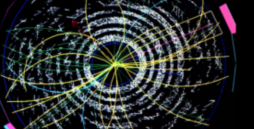Julie Hogan
(Brown University)
06/06/2017, 13:30
Oral Presentation
The Large Hadron Collider is one of the most powerful machines in the world, accelerating protons to 99.9999990% of the speed of light to provide 40 million collisions per second at particle detectors such as CMS. The CMS detector is highly versatile, featuring a 4 Tesla solenoid magnet (the largest superconducting magnet ever built!) and over 100 million detection elements in trackers,...
Ms
Jean Somalwar
(Rutgers University)
06/06/2017, 13:45
Oral Presentation
We present a search for low mass paired dijet resonances using jet substructure techniques. This search uses data from proton-proton collisions at a center-of-mass energy of 13~TeV, recorded by the CMS detector at the LHC. Limits at 95% confidence level are set on the production of top squarks decaying to two quarks in the framework of R-parity violating supersymmetry.
Michael Krohn
(University of Colorado Boulder)
06/06/2017, 14:00
Oral Presentation
A search for heavy resonances decaying into pairs of standard model Higgs bosons is performed using 35.9 $\text{fb}^{-1}$ of data collected by the CMS experiment during 2016 at a center of mass energy of 13 TeV. The final state consists of both Higgs bosons decaying to b quark-antiquark pairs. Results are consistent with the Standard Model expectations and are interpreted as upper limits on...
Cristina Ana Mantilla Suarez
(Fermilab)
06/06/2017, 14:15
Oral Presentation
A search for narrow vector resonances decaying to quarks is presented using events
collected in sqrt(s) = 13 TeV proton-proton collisions with the CMS detector at the
LHC. The data sample, collected in 2016, corresponds to an integrated luminosity
of 35.9 fb−1. The hypothetical resonance is produced with high transverse momentum
such that the decay products of the resonance are merged into...
Dr
Scarlet Norberg
(university of puerto rico mayaguez)
06/06/2017, 14:30
Oral Presentation
Presenting on searchs for the direct production of top squarks in events with multiple jets and large missing transverse energy, using 35.9 fb−1 of data collected by the CMS detector in 2016 at a center-of-mass energy of 13 TeV. Events are categorized into exclusive search regions optimized for different signal topologies. Discussing analysis that use multi variant techniques to identify tops...
Ms
Dipsikha Debnath
(University of Florida)
06/06/2017, 14:45
Oral Presentation
We critically examine the classic endpoint method for particle mass determination, focusing on difficult corners of parameter space, where some of the measurements are not independent, while others are adversely aected by the experimental resolution.In such scenarios, mass dierences can be measured relatively well, but the overall mass scale remains poorly constrained. Using the example of a...
Mr
XIANYI ZHANG
(ILLINOIS INSTITUTE OF TECHNOLOGY)
06/06/2017, 15:00
Oral Presentation
PROSPECT, the PRecision Oscillation and SPECTrum Experiment, is a multi-phased short baseline reactor antineutrino experiment that aims to precisely measure the U-235 antineutrino spectrum and prob for oscillation effects involving a possible ∆m^2 ∼ 1 eV^2 scale sterile neutrino. In PROSPECT Phase-I, an optically segmented Li-6 loaded liquid scintillator detector will be deployed at at the...
Mr
Pranava Teja Surukuchi
(Illinois Institute of Technology)
06/06/2017, 15:15
Oral Presentation
PROSPECT is a short-baseline reactor antineutrino experiment with primary goals of performing a search for sterile neutrinos and making a precise measurement of 235U reactor antineutrino spectrum from the High Flux Isotope Reactor at Oak Ridge National Labo- ratory. PROSPECT will provide a model-independent oscillation measurement of electron antineutrinos by comparing the observed...
